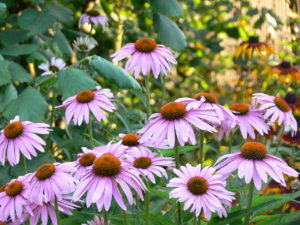Black Samson/ Echinacea Angustifolia
What is it? I stumbled upon this plant while weeding my neighbor’s garden. It was a beautiful flower growing tall and proud, until I chopped it down. I was confused however as it looked like a flower you’d buy at the supermarket; it was very beautiful. I event
ually found the flower in a medicinal plant list! The Black Samson won my heart, and will surely impress you too!
Where to find it? The Black Samson is native to much of Central United States, including Texas, Oklahoma, and Kansas. It can also be found growing native in New York, and parts of the Midwest. Grows well in prairie gardens, roadsides, woodland edges, meadows, pastures, and plains. This plant can be cared for as any other domesticated plant, or allowed to grow wild.
What to eat? The Native Americans used this plant almost more than any other plant! The leaves and flowers are edible and can be eaten like a normal green. However, the rest of the plant should be used for medicinal purposes only, and please do your own research for safety. There are very few people who are allergic to this plant, but it is good to be safe and not sorry, as there are many different kind of Echinacea.
When to find it? You can find this flower from spring to late summer. It is heat and drought resistant, and a good addition to the herbal garden. The best time to harvest the plant is when it is about to be in a complete bloom. After it starts opening up, collect it ad use for both medicinal and topical uses.

By Dy-e on https://commons.wikimedia.org/wiki/File:Echinacea_angustifolia.jpg
What does it look like? Relatively, it should be easy to spot the Echinacea, as the flower is big, brightly colored, and in your face. The flowers are usually cone-shaped, and begin blooming during summer. Some varieties may begin blooming again during the autumn time, but this does not go for every type. After the flowers die, out comes a prickly sort of cone-looking seed head. The leaves are a darker green, with white hairs. They have an ovate shape to them, and toothed. They also have a rough feel to them.
Dangerous Look-alikes? None.
How to enjoy it? As I mentioned above, the Native Americans used this plant a lot! And when the pioneers came the Indians showed them the power of Echinacea. Thus, the lasting legacy of the Echinacea continued on with the pioneers and became a household necessity. When modern medicines came out it eventually lost fame, but that doesn’t keep us from thoroughly enjoying the healthy (and free) flowers God blessed us with. The plant is known to be good for improving your immune system, and it is also aids in vulnerary and lymphatic issues. The root can be used fresh, dried, encapsulated, or powered. Fresh plant juice, or teas can also be consumed for similar results. Historically it was used to treat horses, swelling, small pox, and other common illnesses. The root can be chewed as a painkiller for toothaches, stomachaches, and other internal pain. The root can also used to treat snake bites, caners, burns, sores, wounds, flues, colds, stings, and even the measles! The tea made of the leaves and root can treat the mouth and gums, as well as rheumatism, arthritis and mumps. Something to keep in mind, when used in higher doses, the effectiveness isn’t the same. Use in smaller amounts, and in smaller portions.

